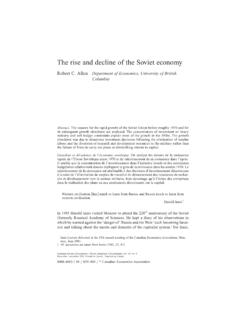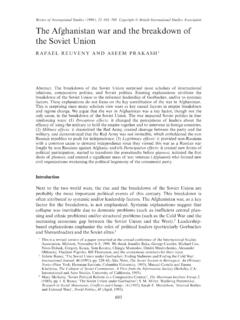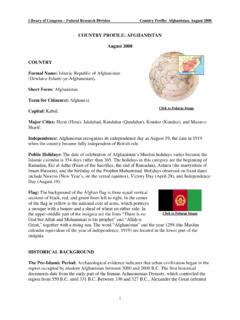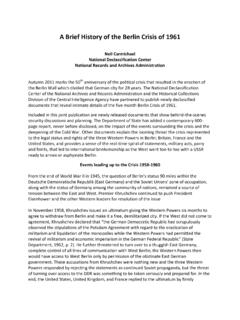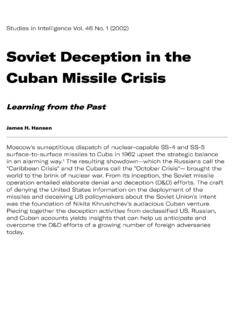Transcription of The Soviet Union after 1945: Economic Recovery and ...
1 The Soviet Union after 1945: Economic Recovery and Political Repression Mark Harrison*. Department of Economics, University of Warwick Centre for Russian & East European Studies, University of Birmingham Hoover Institution on War, Revolution, and Peace, Stanford University Abstract Salient features of the Soviet Union after World War II include rapid Economic Recovery and the consolidation of Stalin's rule. Both Economic Recovery and political consolidation are explained in large part by temporary factors arising from the war.
2 Rapid postwar growth is attributed to the scope arising from a combination of preceding shocks that included the war itself but also stretched back into the prewar years. Political-economy considerations link Stalin's capacity to organizing Recovery while delaying reforms to the quality of repression, based on his exploitation of the war as a source of new information about the citizens over whom he ruled. JEL Codes: E1, N4, P2. * Mail: Department of Economics, University of Warwick, Coventry CV4 7AL, UK.
3 Email: First draft: December 11, 2006. This version: April 14, 2010. The Soviet Union after 1945: Economic Recovery and Political Repression The story of the Soviet Union 's postwar years appears almost as remarkable as the story of the The USSR came to victory in 1945 only after first coming close to total defeat. In 1945 the Red Army occupied Tallinn, Riga, Vilnius, Warsaw, Berlin, Vienna, Prague, Budapest, and Sofia, but behind the army the country lay in ruins. Its people had suffered 25 million premature deaths.
4 The survivors were profoundly weary. Many hoped for reconciliation and relaxation. Despite this, in the years immediately following, the Soviet economy and polity returned quickly to their previous form. There was renewed political and Economic mobilization. Economic resilience was reflected in rapid Soviet postwar Economic Recovery . Political resilience can be seen in Stalin's rapid consolidation of the political system: there would be no reforms for a decade. The rigid hierarchies of party and state control were not loosened up, but were reinforced while their frontiers were pushed outward to the shores of the Baltic and into central Europe.
5 What gave the Stalinist political economy its postwar resurgence? I will place the Soviet Recovery in a broader European context. The result is a puzzle: across most of Europe there was a clear association between postwar prosperity and Economic and social reforms, but not in the Soviet Union . A closer look at Soviet postwar institutions in the late 1940s suggests that if anything they were more centralized, militarized, secretive, and punitive than in the late 1930s. The rapid Soviet Economic Recovery from World War II becomes less surprising when we take into account the Soviet economy's very large backlog of unexploited potential, not all of it due to the war.
6 Institutions are still important, though, because ineffective institutions can mean that unexploited potential is never realized. In one respect, unchanged Soviet institutions could operate more efficiently than before: the war gave Stalin new information about his enemies, and he could exploit this temporarily to improve the quality of repression. To summarize, a large backlog of unexploited Economic potential and more efficient repression were two sources of postwar Soviet Economic resilience, but their common feature was that they were both temporary.
7 1945 in Perspective On the eastern front, World War II was devastating. In four years, fought mostly on Soviet territory, the war killed one in eight Soviet citizens, and destroyed one third of their national wealth. The country was full of displaced people and torn families. Industry was struggling to restore peacetime production. In comparison, Russia's seven-year Great War and Civil War of 1914 to 1921 were only somewhat less devastating. Also fought mostly on Russian territory, the Great War and Civil War killed around one in ten citizens of the former Empire through fighting, disease, and Through the 1920s, the Bolshevik leaders struggled to get the economy back to square one the level of 1913.
8 In this sense, the Soviet Union was itself a project of postwar In 1929, when Stalin launched his Great First draft: December 11, 2006. This version: April 14, 2010. 2. Breakthrough to forced-march industrialization and the all-out collectivization of peasant farms, the Soviet economy was probably still lagging behind the prewar benchmark of output per head of the Although the human losses from World War II were on a wider scale, Soviet Recovery after 1945 was also more rapid. The economy was in far better shape than in 1921.
9 Both wars were followed by harvest failure and regional famine, but the famine of 1946 killed a fraction of the numbers that died of hunger at the end of the Civil Average Soviet incomes climbed back to their prewar (1938) level as early as 1948. after the Civil War, in contrast, it took seven to ten years of peace for average Soviet incomes to struggle back to the 1913 level. In the Soviet Union , as elsewhere, the restoration of pre-World War II output turned out to be the prelude to a prolonged postwar acceleration of growth that persisted long after this moment.
10 Across Europe, there was a Golden Age of Economic growth and rising living standards that continued through the 1950s and Despite restricted East-West trade, heavier burdens of defence and investment, and a lower average starting point, Soviet consumers also experienced gains comparable with those of Western Europeans. Table 1. War Damage and Reconstruction in Europe: years and percent per year, annual average Annual growth, per cent, per head fell below 1945. per head exceeded 1938. per head exceeded 1938.










